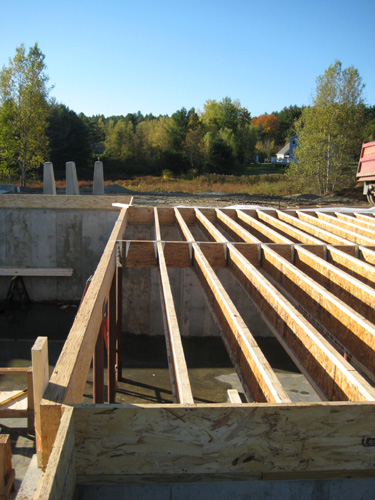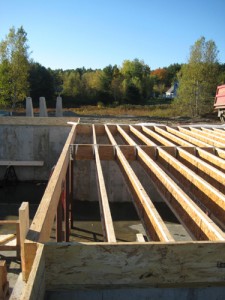Selecting TJI Floor Joist Sizes


Sizing Trus Joist TJI’s


First you’ll need to download the most current Trus Joist TJI Manual. The design manual contains all the span tables for different sizes and orientations of joists. The manual also includes span tables based on different deflection criteria. Also included in the manual are extremely important construction and safety details that need to be followed for a safely framed floor system.
Recent Posts
Framing Stick Nailer vs Coil Nailer
Which is Better a Stick Nailer or Coil Nailer? Framers have many choices in nailers…
How Many Roofing Nails Per Square of Shingles
Estimating How Many Nails for a New Roof When it comes to estimating materials for…
Composite / PVC Decking – Layout Tips & Advice
Composite / PVC Decking Layout Tips and Advice Composite and PVC decking have really changed…
Benefits of an ERV System (Energy Recovery Ventilator)
Benefits of ERV Systems (Energy Recovery Ventilator) If you're building a new home or doing…
Vermiculite Attic Insulation Abatement
Vermiculite Attic Insulation If your home was built before 1990 there is a chance it…
Nuisance Tripping of AFCI (Arc Fault) Circuit Breakers
Arc Fault (AFCI) Circuit Breakers Tripping Often An arc-fault circuit interrupter (AFCI) or arc-fault detection…
View Comments
how do you attach to concrete stem wall. it would be helpfull to have a picture for the want to build your own home person.i will soon be using this product.
Alan - Can you be more specific? Are you hanging the joists from the face of the wall or will the joists be sitting on top of the wall?
So, I am remodeling a garage (20' ceiling) to add a second floor. My plan is to lag bolt 2x12's to the existing studs in the walls and run TJI in hangers across the span. Is this ok? Anything I should be looking at?
Mark - You need to be sure you have proper bearing. Quite often you need more than 1-1/2" of bearing.
The helpful TJI advice and related links much appreciated. Thanks!
I have a 24'x 24' gabel roof garage with loft for storage. loft is made from 2"x 8" joist spaning across 24', 24"oc with 1/2" plywood floor. Rafters are 2"x 6" 24" oc, set on 2"x 8" ridge board, notched on to walls. the roof has 7-12 pitch. the joist sit on top of 2"x 4" walls nailed to rafters. Walls are 8' made of 2"x4" 16"oc with double top plate. I would like to use the loft as a lounge possably adding a dormer on one side of the roof. What can I do to stengthen the joist and floor. I have thougth of sistering 2"x10" to the 2"x8" and adding one between ea. to make it 12"oc. Would this be enough. I've been told also to attach 2"x4" to the joist and raffters about 6' in, but that would kill the dormer. Could i just do it on one side and leave the other side open.
Is there a center support in the middle of the 24' span? If not you'll be hard pressed to span 24' without using some serious TJI's. You'd likely be better off removing the old joints one at a time and replacing with a properly sized TJI. However, the depth of them will be a concern. you may need to create a ledger and drop them down which ultimately drops your garage ceiling height down.
Any photos?
No center support. There is four to five inches clearance over the top of the overhead door. The ledger (to the wall?),sounds like it would work, how would I attach it, and what dimension. I have photos. I've subscribed via e-mail.
First off let me say you really need to work with a local building supplier or structural engineer to select the proper joist. Without knowing you entire situation and local building code requirements I can not give you a final solution.
However, just for talking purposes, if you look at the table you will see that you'll need something like a TJI 230, 14" deep, spaced at 12 inches on center. So then the challenge becomes how do you get them in place without the roof falling down! Honestly you'd be better off with a center column/beam arrangement.
My first floor is made up of 2x10 joist's, that are 13' long. The floor has some bounce in it, and I was hoping to eliminate some, if not all, of the bounce. One idea would be to glue and screw some 3/4" plywood to every other joist, and then, add bracing every 4". What do you think?
Thank You
That approach will definitely stiffen the floor. I'd install the plywood on every joist but just do the middle 8' of the joists. This is where bending stresses are highest. Bridging will also help out quite a bit. This helps engage more than one joist when a load is applied to it.
Good luck.
Todd,
Thank you for the reply.
Should I just add the plywood to one side of the joist, or both? Should I jack the joist, before screwing and gluing the plywood? What type of plywood should I be using?
Thank You
From your description it should like you're trying to fix "bouncing" of the floor. This is due to what we refer to as live load. So no jacking is required. Me personally I'd add plywood to both sides to keep things symetrical. I'd use 1/2" thick CDX plywood.
When adding the plywood, to both sides of every other joist, should I just glue and screw both pieces to the middle of the joist, or should I stagger the pieces, on each side of the joist? Should I still add the plywood to every other joist? Do you think 3' is a good space, for the bridging, or should it be more or less?
I would do every joist so the floor has an even distribution of stiffness. Not sure what you mean by staggering, I'd just use an 8' long piece at mid-span, both sides of the web.
3' is more than enough, 4' spacing willl likely work well as well.
The strongest option is 1 or maybe 2 rows of bridge blocking. A 9 1/8" plywood strip, even on both sides will not stiffen enough to stop live load deflection at length.
Hi Todd,
First off, thanks for putting this website together! Very helpful.
I am a home designer and have a question about TJI sizes/ spacing vs. cost. In your experience, is it less expensive to go with a tighter spacing with a lighter joist, or wider spacing with a heavier joist?
Regards, Larry
Typically the best solution is one that uses 16" o.c. spacing. That spacing works well with 3/4" sub-floors and finished flooring and it requires less labor than a 12" o.c. spacing. Obviously there are times when that won't work but that's typically my preference.
I would like to confirm what floor joist will yield a strong floor. I will be 24 foot outside to outside of 2x6 exterior walls of a 42 foot long home and want to keep the first floor open by using TJI joists running right to left. I will have a 12/12 pitch roof so when I get upstairs there will be a vertical wall from center outwards, at 6 foot running from front to back and supporting a stick framed 2x8 rafter...or a 12 foot room the length of the house...so the load from the roof will essentially bear at 6 foot from the downstairs exterior walls inward if I am giving a proper mental image. I am in upstate NY and want the most rigid floor I can get within reason. I don't want my daughter running back and forth and watching the floor/ceiling move before my eyes. I like to think of this as a heavy duty request/inquiry.
Earl - With a configuration like that you'll need to confirm sizing with a TJI rep. Most distributors have staff that are trained to use their design software and confirm sizing. Taking a quick look at the charts you're going to need a 14" or 16" deep joist. Spacing and model will depend on how much loading that upper wall framing adds to the span.
The deeper 14" or 16" joists will need to be accounted for in floor to floor heights for stair design and details.
Hi I have TJI 560 series 16 inch and 16oc spanning 21 ft I have a 16 inch rim boards. Do I need squash or web fillers at the top plates at the load ends. My tji are all cut tight to the rim board If I need them how would you apply in place. Glue then screw .this is for a second floor floor joist
Thanks
Frank - You'd have to look at their standard details. Typically we only see squash blocks at interior load bearing locations but it's certainly possible. Installing them wouldn't be a big deal, typically a vertical 2x4 on each side of the flange, tight to the plate below and tight to the sub-floor above would be used.
Todd,
I am looking at a cantilevered radius on the second floor. The projection at the widest point is about 36". I am familiar with a doubled LVL at 1 1/2 times the cantilevered length inside the wall. I will turn the LVL beam at a 45 degree angle to the corner where the radius projects. Should I use LVL's as floor joists? It doesn't appear that a 14" TGI will support the span.
Craig
Can you be more specific about the layout...not sure I really understand what you're building.